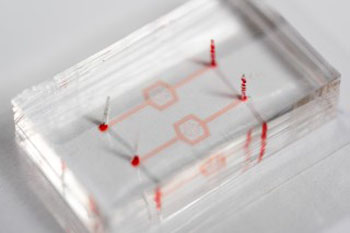Physical Considerations Regulate Leukocyte Motion in the Circulatory System
By LabMedica International staff writers
Posted on 23 Feb 2016
A team of biomedical engineers constructed a model circulatory system within a polymer microchip, creating a tool that enabled them to show that the relative hardness or softness of white blood cell leukocytes determined whether they clung to the edges of blood vessels or circulated freely with the blood.Posted on 23 Feb 2016
Leukocytes normally migrate toward the vascular walls in large blood vessels and within the microvasculature in a process called margination. Reversal of this process, leukocyte demargination, leads to substantial increases in the clinical white blood cell and granulocyte count and is a well-documented effect of glucocorticoid and catecholamine hormones, although the underlying mechanisms remain unclear.

Image: Researchers used a model blood vessel system built into a polymer microchip to study the activity of white blood cells as they were affected by drugs that tend to make them softer, which facilitates their entry into blood circulation (Photo courtesy of Rob Felt, Georgia Institute of Technology).
To clarify this matter investigators at the Georgia Institute of Technology (Atlanta, USA) and Emory University (Atlanta, GA, USA) used the microchip circulatory system model to study the purely physical parameters that influenced the motion of white blood cells in the presence—and absence—of the drugs dexamethasone—a glucocorticoid drug—and epinephrine. Atomic force microscopy was used to characterize the stiffness of individual white blood cells before and after they had been exposed to the drugs.
Results published in the February 8, 2016, online edition of the journal Proceedings of the National Academy of Sciences of the United States of America (PNAS) revealed that glucocorticoid and catecholamine exposure reorganized cellular cortical actin, significantly reducing leukocyte stiffness, as measured with atomic force microscopy. Furthermore, using simple kinetic theory computational modeling, the investigators determined that this reduction in stiffness alone was sufficient to cause leukocyte demargination.
“When we fluorescently label the white blood cells and perfuse them into the artificial vessels, the white blood cells are always flowing along the edge, on the walls of these artificial blood vessels,” said senior author Dr. Wilbur Lam, assistant professor of biomedical engineering at the Georgia Institute of Technology and Emory University. “But when they are exposed to the drug, they go to the center of the channel and enter the main blood flow. Then, we discovered that the drugs cause the cells to remodel actin, which comprises the "skeleton" of all mammalian cells. The soft cells are always flowing in the middle of the bloodstream, while the stiff ones are sequestered on the edges. We believe this is how white blood cells traffic in the body and get to the site of an infection. This may be a way that the body very efficiently sorts and directs its white blood cells to get them where they are needed.”
“Whenever there is a change in some cellular activity or physiological activity, we tend to try to explain everything at the genetic level – which genes turn off and which genes turn on,” said Dr. Lam. “Gene expression is a relatively complex process, and our hypothesis is that there are probably a lot of cellular processes that are much simpler and more efficient than the typical paradigm of DNA expression, then RNA translation, and then protein production. A little tweak of a white blood cell’s actin will allow it to change from stiff to soft, and that small change, in and of itself, may have profound physiologic consequences and enable it to be transported from one part of the body to another.”
Related Links:
Georgia Institute of Technology
Emory University














